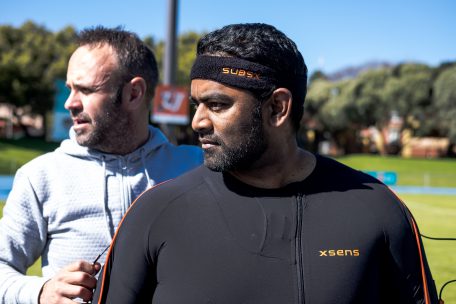HOT
 Xsens’ new MTi 600-series wins AUVSI XCELLENCE …
Xsens’ new MTi 600-series wins AUVSI XCELLENCE … The Future Group, Xsens and IKINEMA partner up
The Future Group, Xsens and IKINEMA partner up Live data analysis of the long jump at the FBK G…
Live data analysis of the long jump at the FBK G… Xsens and Ergoneers join forces to launch ergono…
Xsens and Ergoneers join forces to launch ergono… New MTi 600-series industrial-grade inertial sen…
New MTi 600-series industrial-grade inertial sen… Xsens North America Celebrates New Office Grand …
Xsens North America Celebrates New Office Grand … Xsens’ latest update takes outdoor motion captu…
Xsens’ latest update takes outdoor motion captu…
Injury Prevention and Prosthetic Enhancement
Based in Johannesburg, the Wits Physiotherapy Movement Analysis Laboratory at the University of Witwatersrand aims to extrapolate kinematic, kinetic, and biomechanical data for practical uses outside of the lab, providing an insightful body of research for professional athletes. We spoke with one of the Lab Coordinators, Mr. Jaco Liebenberg, to discuss the data and lay out some of the University’s exciting findings.
Together with Prof. Benita Olivier, Lab Leader, and Prof. Hellen Myezwa, Head of Physiotherapy, Jaco aims to obtain the most accurate data for realistic applications. To achieve this target, the researchers need an in-depth, uncompromising method of capturing the most acute angular movements both in and outside of the lab. The advanced technology and versatile nature of the Xsens inertial suits provide data-driven insight, with an ever-expanding array of potential uses coming to fruition.
Pushing the boundaries of motion research

“With the Xsens suit, we’re able to cross academic bridges that were previously unattainable. One example is prosthetic development, we can now help coordinate and customize with the engineering department, providing a means to analyse whether each prosthetic is applicable and whether it’s working for the user’s unique needs and body. It’s opened doors to collaborate with other departments, from injury prevention, to surgery.”
The opportunity to take their analysis outside of the lab has acted as an integral catalyst for the department’s expansive research capabilities, with sports that were previously difficult to analyse becoming topics of attainable intrigue.
“Being able to test outside of the lab directly with athletes and medical patients, it’s very important to us. We can push the limits of research. With Golf, the long-range course would usually provide difficulties in a lab, but we were able to get data we never acquired before by going outside the lab.”

With a specialist background in injury prevention, Mr. Liebenberg has recently supported a research project for Cricket, specifically locating the load on lower backs and limbs as a means to prevent injury. Due to the repetitive movements of bowlers, strain can occur over time, but the added detail achieved via motion-capture on the field is opening up significant gains in performance optimization.
Paralympic success
Extending his injury prevention research, Jacobus’ latest focus pin-pointed Paralympic athlete and Bronze medalist, Tyrone Pillay, analyzing his technique to enhance performance and prevent injury. Shot-put is a sport that relies on strength, short bursts of energy, and a conjunctive sequence of movements leading up to the throw. Motion capture can record the fluidity of the movements, with each one affecting performance in a unique way. Tracking Tyrone on the field allows for a personalized scope and analysis, as well as the ability to record in Tyrone’s training environment.

“Because Tyrone has a lower limb prosthetic, the dynamic and weight of it had to be considered. We aimed to discover how the prosthetic limb could be optimized for performance. Using Xsens, it’s possible to measure the strain on the limb and see if that design matches up with Tyrone’s performance. There aren’t many studies that look at prosthetics using motion capture in field conditions, but we believe this is a huge advancement.”
The Xsens data recorded on the field gave us specific new insights that were then passed on to the prosthetist and engineers. This information was then used to optimize the prosthetic leg for Tyrone’s unique use.
Real world application

One of the more exciting aspects of using motion capture outside of controlled conditions is the convergence of specific movements such as a singular technique and its correspondence to a fully-fledged event.
“A great example would be one hurdle versus a full race. We are able to measure the single movement, but in the field, we can see how that movement changes as the athlete runs through different stages of fatigue and psychological conditions (example, race vs training conditions).”
A goal of Jacobus’ team is to establish concrete parameters for disabled and abled athletes, with motion capture leading the research. However, the findings of the University of Witwatersrand are opening doors to breakthroughs outside of sport. In partnership with Natalie Benjamin-Damons, Jacobus has been looking at gait differences in HIV and non-HIV patients with neuropathy, with promising signs for the prevention of long-term injury.

“The goal is to identify the unique indicators and differences between each population, preventing injuries and consequently, improving their quality of life.”
The research conducted by the University of Witwatersrand is continuing to push boundaries, with inertial motion capture providing a greater body of data and ever-increasing list of opportunities.




































